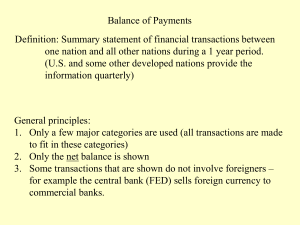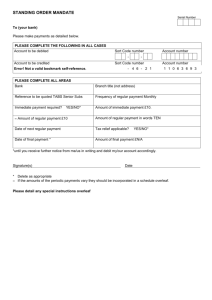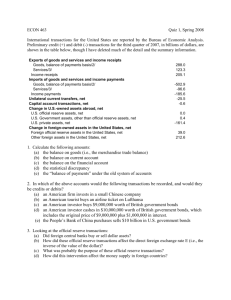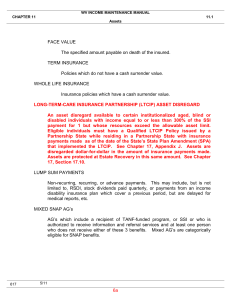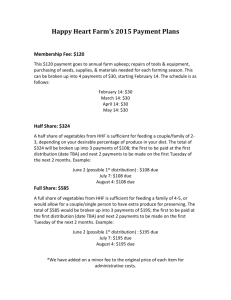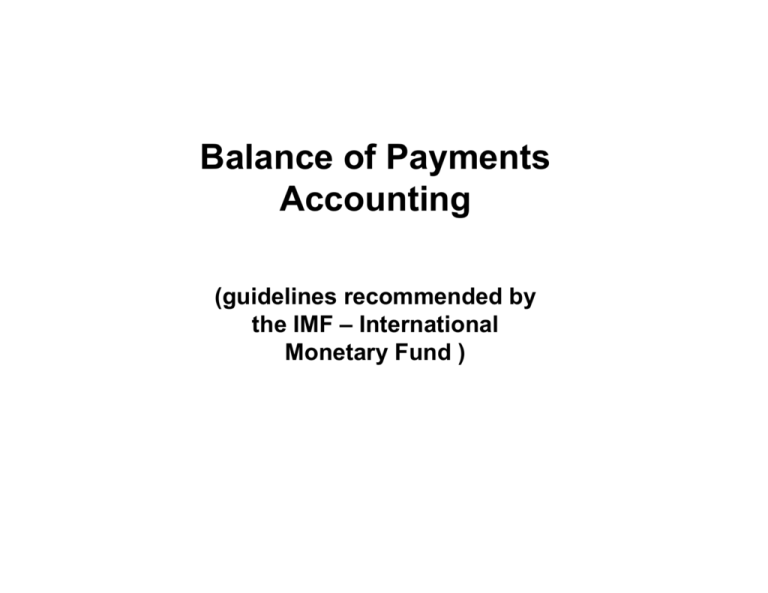
Balance of Payments
Accounting
(guidelines recommended by
the IMF – International
Monetary Fund )
To understand the factors that affect international trade and lending first
requires basic knowledge of Balance of Payments.
International transactions. Some numbers positive and others negative.
•
Any transactions that involves a flow of funds into home country
(Brazil, US) is a credit item (plus sign).
•
Any transaction that involves a flow of funds out of home country
(Brazil, US) is a debit (minus sign).
Components of the Balance of Payments:
1. Current Account – measures a country´s trade in currently produced
goods and services, along with unilateral transfers between countries.
We can divide into three parts: (a) net exports of goods and services, (b)
net income from abroad, and (c) net unilateral transfers.
a. Net Exports of Goods and Services – two categories:
• net exports of goods ( Japonese cars, Brazilian coffee, French
perfume – trade balance) and;
• net exports of services (transportation, tourism, insurance).
b. Net Income from Abroad (or net factor payments) – income receipts
from abroad minus income payments to residents of other countries.
• income receipts flowing into a country – credit items in the current
account (CA) that consist of compensation received from residents
working abroad (salary) plus investment income from assets abroad
(interest, profit, dividend payments – from bonds, stocks etc).
• income payments flowing out of a country – debit items in the CA that
consist of compensation paid to foreign residents working in the
country plus payments to foreign owners of assets in the country.
Examples:
• Wages paid by a Brazilian company to a Swedish engineer who is
temporarily working in Brazil, or
• dividends paid by a Brazilian company to a US owner of stock in
the company, or
• profit remittances from multinationals.
c. Net Unilateral Transfers – are payments from one country to
another that do not correspond to the purchase of any good,
service, or asset.
It equals unilateral transfers received by the country minus unilateral
transfers flowing out of the country. Negative value, country is a net
donor to other countries.
Examples: official foreign aid (payment from one government to
another) or a gift of money from a resident of one country to family
members living in another country.
Current Account Balance: the number that adds all the credit items
subtracting all the debit items. If CA is positive, the value of credit items
exceeds the value of debit items.
2. The Capital and Financial Acoount
International transactions involving assets, either real or financial, are
recorded in this account, which consists of a capital account and a
financial account .
•
Capital account – category that encompasses unilateral transfers of
assets between countries, such as debt forgiveness or migrant´s transfers
(the assets that migrants take with them when they move into or out of a
country). It measures the net flow of assets unilaterally transferred into
the country.
• Financial account – most transactions involving the flow of assets
into or out of a country are recorded in the financial account.
When the home country sells an asset to another country, the
transaction is recorded as a financial inflow for the home country and a
credit item in the financial account of the home country.
Example:
If a U.S. hotel is sold to Italian investors, the transaction is counted as
financial inflow to the U.S. and therefore as a credit item in the U.S.
financial account because funds flow into the U.S. to pay for the hotel.
Others financial inflows: if U.S. company borrows from a Britsh bank;
a New York bank receives the amortization on its loans to Brazil.
The financial account balance equals the value of financial inflows
(credit items) minus the value of financial outflows (debit items).
When residents of a country sell more assets to foreigners than they
buy from foreigners, the financial account balance is positive, creating
a financial account surplus.
When residents of the home country purchase more assets from
foreigners than they sell to foreigners, the financial account balance is
negative, creating a financial account deficit.
The capital and financial account balance is the sum of the capital
account balance and the financial account balance.
The Officials Settlements Balance – one set of financial account
transactions (transactions in official reserve assets) has been broken
out separately. They differ from others in this account because they are
conducted by central banks (FED official institutions that determine
national money supplies).
Held by central banks, official reserve assets are assets, other than
domestic money or securities, that can be used in making international
payments.
Ex of reserve assets: gold, government securities of major
industrialized economies, foreign bank deposits, and special assets
created by the IMF.
Central banks can change the quantity of official reserve assets they
hold by buying or selling reserve assets on open markets.
Example: the Fed could increase its reserve assets by using dollars to
buy gold.
A country that increases its net holdings of reserve assets during a year
has a balance of payments surplus, and a country that reduces its net
holdings of reserve assets has a balance of payments deficit.
For the issues we will discuss in this course, the balances on current
account and on capital and financial account play a much larger role
than the balance of payments.
Relationship Between the CA and the Capital and Financial account
(KFA)
The logic of BP accounting implies a close relationship between the CA
and KFA.
Except for errors arising from problems of measurement, in each period
the CA balance and the KFA balance must sum to zero.
CA + KFA = 0
Reason: each transactions among countries (residents and non
residents) generates a debit item and a credit item in the BP.
Ex: an american buys an imported British sweater, paying $75 for it.
Transaction record: debit in imports (negative CA balance) and credit in
reserves (reduced reserves but positive KFA balance)
This example shows why, conceptually, the CA balance and KFA
balance must always sum to zero.
In practice, problems measuring international transactions prevent
this relationship from holding exactly – statistical discrepancy.
Ex: CA is equal to (- 220.6) and KFA is equal to 210.4, statistical
discrepancy must be 10.2.
If the U.S. CA balance is negative, U.S. receipts of payments from
foreigners are not sufficient to cover U.S. payments to foreigners.
To offset this excess of payments over receipts, the U.S. must borrow
from foreigners or sell to foreigners some U.S assets (to finance its
CA deficit). In this case foreigners use their saving to lend to the U.S.
or to acquire U.S. assets.
Balance of Payment structure
1. Current Account
I. Trade balance – exports of goods minus import of goods
II. Service balance – exports of services minus import of services
III. Income balance – net compensation of employees and investment
income.
IV. Net unilateral transfers
__________________
I + II + III + IV = CA
__________________
2. Capital and Financial Account
A. Capital account
B. Financial account
a. direct investment
b. portfolio investment
c. other investment (loans, amortization, financing)
C. Errors and Omissions (statistical discrepancy)
_______________________
CA + A + B + C = Balance of Payments
_______________________
Reserves (gold, special drawing rights, reserve position in the IMF and
other claims)

